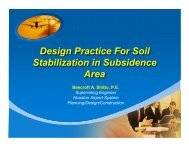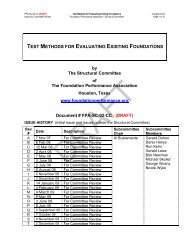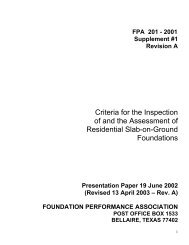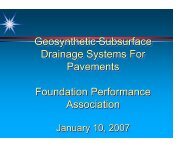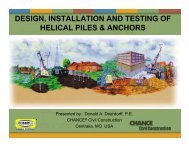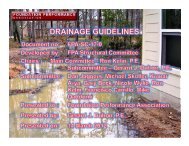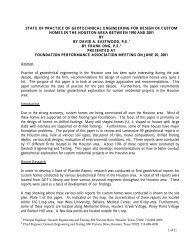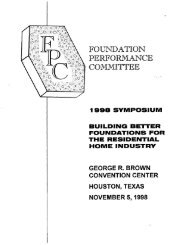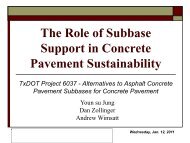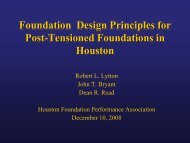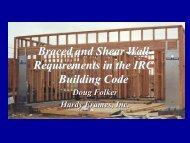Soil-Structure Interaction Seminar - Foundation Performance ...
Soil-Structure Interaction Seminar - Foundation Performance ...
Soil-Structure Interaction Seminar - Foundation Performance ...
You also want an ePaper? Increase the reach of your titles
YUMPU automatically turns print PDFs into web optimized ePapers that Google loves.
Concrete Placement Monitoring<br />
The concrete sampling and testing in the floor slab and placement areas will be conducted in<br />
accordance with ASTM standards. A technician will monitor hatching and placing of the<br />
concrete. At least four concrete cylinders should be made for each floor slab pour. Two<br />
concrete cylinders are tested at seven days and two cylinders at 28 days.<br />
General<br />
HOMEOWNER MAINTENANCE PROGRAM<br />
<strong>Performance</strong> of residential structures depends not only on the proper design and construction,<br />
but also on the proper foundation maintenance program. Many residential foundations have<br />
experienced •major foundation problems as a result of owner's neglect or alterations to the initial<br />
design and landscaping. This has resulted in considerable financial loss to the homeowners,<br />
builders, and designers in the form of repairs and litigation.<br />
A properly designed and constructed foundation may still experience distress from vegetation and<br />
expansive soil which will undergo volume change when correct drainage is not established or<br />
incorrectly controlled water source becomes available.<br />
The purpose of this document is to present recommendations for maintenance of properly<br />
designed and constructed residential projects in Houston. It is recommended that the builder<br />
submit this document to his/her client at the time that the owner receives delivery of the house.<br />
Drainage<br />
The initial builder/developer site grading should be maintained during the useful life of the<br />
residence. In general, a civil engineer develops a drainage plan for the whole subdivision.<br />
Drainage sewers or other discharge channels are designed to accommodate the water runoff.<br />
These paths should be kept clear of debris such as leaves, gravel, and trash.<br />
In the areas where expansive soils are present, positive drainage should be provided away from<br />
the foundations. Changes in moisture content of expansive soils are the cause of both swelling<br />
and shrinking. Positive drainage is extremely important in minimizing soil-related foundation<br />
problems. Sometimes, the homeowners, mount the flowerbed areas, creating a dam, preventing<br />
the surface water from draining away from the structure. This condition may be visually<br />
appealing, but can cause significant foundation damage as a result of negative drainage.<br />
The most commonly used technique for grading is a positive drainage away from the structure<br />
to promote rapid runoff and to avoid collecting ponded water near the structure which could<br />
migrate down the soil/foundation interface. This slope should be about 3 to 5 percent within 10feet<br />
of the foundation.<br />
GEOTECH ENGINEERING AND TESTING, INC. -------------·<br />
18



